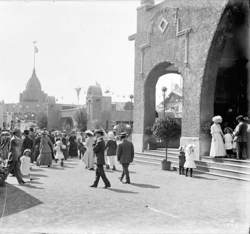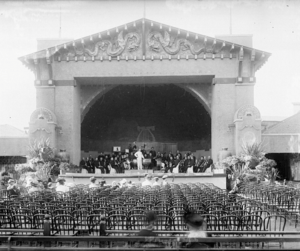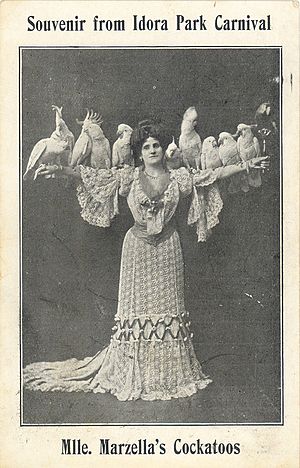Idora Park facts for kids

Idora Park crowds, c. 1912
|
|
| Location | Oakland, California, U.S. |
|---|---|
| Coordinates | 37°50′32.62″N 122°15′47.36″W / 37.8423944°N 122.2631556°W |
| Status | defunct |
| Opened | 1904 |
| Closed | January 1929 (25 years) |
| Theme | Trolley park |
| Area | 17.5-acre (71,000 m2) |
Idora Park was a fun and exciting amusement park in Oakland, California. It opened in 1904 and was a special kind of park called a "trolley park." This meant people mostly arrived by trolley (like a streetcar). The park was built on 17.5 acres of land and quickly became a popular spot for families and friends from all over the San Francisco Bay Area. It was known for its rides, shows, and many attractions. However, as cars became more common, fewer people rode trolleys to the park. Idora Park closed its gates in 1929 and was later taken down.
Contents
The Story of Idora Park
How Idora Park Began
The park was built in 1903 by a company called The Realty Syndicate. It was located in North Oakland, near Temescal Creek. The main entrance was on Telegraph Avenue. When it first opened, it already had a "sky railway" roller coaster. The park was surrounded by a wall, and it cost only 10 cents to get in! It stayed open for many months each year, offering lots of fun.
Running the Park
The Ingersoll Pleasure and Amusement Park Company managed Idora Park. They ran several other parks in the eastern United States. The park was almost named Kennywood Park, but it's thought that Mr. Ingersoll named it after his daughter, Idora. The Realty Syndicate, which owned the park, also owned the Key System transit company and other big properties in the area. A man named Bertrand York managed the park from 1911 until it closed.
The Idora Park Opera Company
Idora Park became famous for its opera house. After the big 1906 San Francisco earthquake, many people lost their homes. Idora Park helped by giving shelter to about 2,500 people. The park provided food and supplies during this difficult time.
After the earthquake, talented performers from San Francisco's Tivoli Theater moved to Oakland. They formed the Idora Park Opera Company. They put on popular shows like The Mikado and The Pirates of Penzanza in a wooden theater called the Wigwam Theater. These shows were a big hit with visitors!
Exciting Rides at Idora Park
Rides at Idora Park usually cost just 5 cents. Many were advertised as being the "largest" or "first" of their kind. The names of the rides often changed, but they were always thrilling! Some popular rides included Dodge 'em, The Whip, and the Magic Carpet.
- The Circle Swing: A large round disk with seats that swung high in the air.
- The Social Whirl: A platform that spun fast, pushing riders off with centrifugal force.
- The Flying Swing: A swing ride where cars lifted high as they spun around.
- Barrel-of-Fun: A classic funhouse attraction.
- Trip through Hades: A mysterious dark ride.
- Helter Skelter: A tall slide that twisted down.
- Chutes: A boat ride that plunged down a ramp into water.
- Miniature railway train: A small train that took people on a tour of the park.
- Ferris wheel: A classic ride offering great views.
- Merry-go-round: A favorite for all ages.
- The Mountain Slide: A slide that looked like it went through a mountain.
- The Auto Race Course: A circular track where two electric cars raced each other.
Roller Coasters
Idora Park had five different roller coasters during its history, each offering a unique thrill!
- Ingersoll Figure 8 Toboggan: This coaster ran from 1906 to 1916.
- L.A. Thompson Scenic Railway: Operated from 1906 to 1921.
- Race Thru The Clouds: A coaster with two tracks, allowing riders to race.
- The Big (or Giant) Dipper: Designed by John A. Miller, this huge coaster operated from 1922 to 1928.
- Skyrocket (or Thunderbolt): Also designed by Miller, this coaster ran from 1927 to 1928.
Amazing Attractions
Idora Park was more than just rides; it had many unique attractions and shows!
In the early 1900s, the park even hosted demonstrations of flying machines! People watched as gliders and dirigibles (like small airships) took to the sky. Thomas Baldwin made the first successful round-trip flight in the United States with his dirigible, The California Arrow, right at Idora Park in 1904.
The park also had some amazing technology for its time:
- The first outdoor public address system.
- The largest horn loudspeaker ever built by Magnavox.
- The first radio theater in the West.
- A giant searchlight, said to be the largest in the world.
- A huge Victrola tower, playing music for everyone.
- The largest roller skating rink west of Chicago! Famous comedians Charlie Chaplin and Buster Keaton even practiced their skating skills there.
Inside its walls, Idora Park also featured a zoo, an ostrich farm, shows with performing animals, a dance hall, and a racetrack. There was an outdoor amphitheater, a peaceful Japanese garden, and a special area for bears. The main street was called the Glad Way, and you could find a penny arcade, a photo gallery, and a shooting gallery.
In 1904, a ballpark with seats for 3,000 people was built. After the 1906 earthquake, a major baseball league even played there. On Saturday nights, the Mountain Slide would put on a firework show that looked like a volcanic eruption! Hot-air balloons would also launch, with acrobats parachuting down.
For games, you could try "The Laying Hens." If you hit a wooden hen with a ball, it would drop a hard-boiled egg for you to eat! The park also offered electric souvenirs, table tennis, a musical arcade, and many places to get refreshments.
Fun Entertainment
Idora Park's stages hosted many Vaudeville performers, who put on a variety of acts. Some famous stars who started their careers in the Oakland area and performed at Idora Park included Hobart Bosworth, Fatty Arbuckle, Mabel Normand, and possibly Lon Chaney.
Aimee Semple McPherson, a famous speaker, held a very large outdoor baptism in the park's swimming tanks, with 10,000 people watching.
Tasty Treats
Idora Park was well-known for its delicious cream waffles. You could also buy ice cream, popcorn, and Coney Island "Red Hots" (hot dogs) for just a nickel. The park's restaurant offered full meals for 75 cents to a dollar, and soda pop was available in big 12-ounce bottles.
The Park's Closing
Idora Park's popularity began to fade as more people owned cars. They could now drive to other places, like Neptune Beach in nearby Alameda. The park closed in January 1929 and was taken down later that year. The land was eventually used to build homes and apartment buildings.
In the 1930s, the area became a lively neighborhood, and a new roller rink called Rollerland was built nearby.



